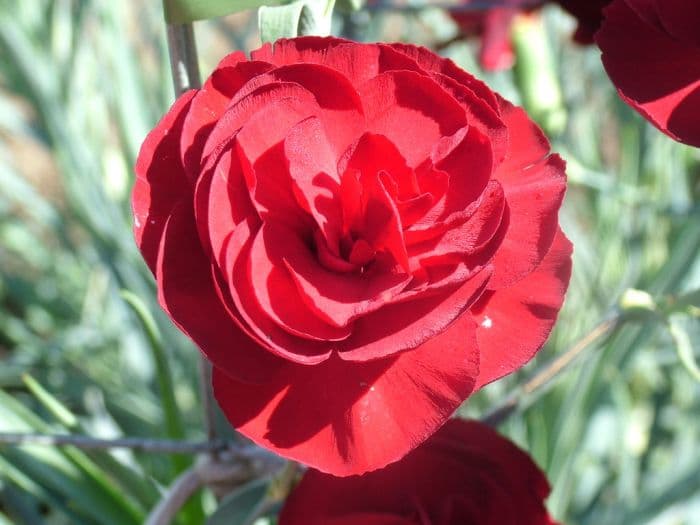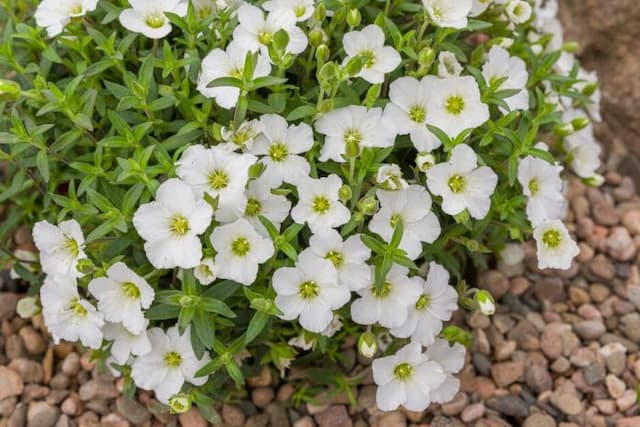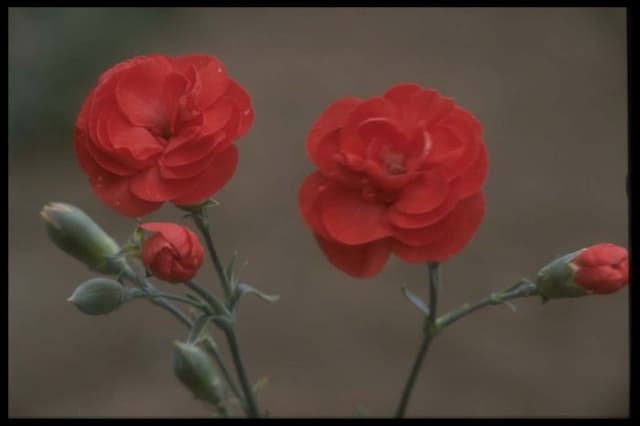Sweet William Dianthus 'Spinfield Crimson' (b)

ABOUT
The Dianthus 'Spinfield Crimson' is a striking plant primarily known for its vibrant crimson flowers. These flowers are characterized by their frilled edges, giving them a distinctive ornate appearance. The petals have a slightly velvety texture and typically showcase a central eye that can be a contrasting color, often a paler hue or a darker crimson. The foliage of Dianthus 'Spinfield Crimson' is also noteworthy. The leaves are slender, with a blue-green color that complements the red petals well. They form a dense, mat-like growth beneath the flowers, creating a lush backdrop for the blooms. Throughout its blooming season, the Dianthus 'Spinfield Crimson' offers an impressive display of color and texture. Its blossoms are particularly favored for cut flower arrangements thanks to their bold appearance and longevity. The plant is also known for a delightful fragrance that is both sweet and spicy, which adds to its garden appeal.
About this plant
 Names
NamesFamily
Caryophyllaceae
Synonyms
Sweet William, Pinks
Common names
Dianthus 'Spinfield Crimson'
 Toxicity
ToxicityTo humans
Dianthus 'Spinfield Crimson', commonly known as Sweet William, is not known to be toxic to humans. However, as with many ornamental plants, it is not intended for ingestion, and eating plant parts could potentially cause mild stomach upset or an allergic reaction in some individuals. There are no specific symptoms of poisoning associated with Sweet William because it is not considered poisonous to humans.
To pets
Sweet William is generally considered non-toxic to pets. It is unlikely to cause poisoning if ingested by cats, dogs, or other household pets. However, some animals may experience mild gastrointestinal upset after eating parts of the plant, such as vomiting or diarrhea. It is always best to prevent pets from eating ornamental plants as individual reactions can vary.
 Characteristics
CharacteristicsLife cycle
Perennials
Foliage type
Evergreen
Color of leaves
Blue-green
Flower color
Crimson
Height
1 foot [30 cm]
Spread
1 foot [30 cm]
Plant type
Herb
Hardiness zones
6
Native area
Europe
Benefits
 General Benefits
General Benefits- Attractive Flowers: Dianthus 'Spinfield Crimson' is known for its stunning crimson blooms which add vibrant color to gardens and landscapes.
- Pleasing Fragrance: The flowers typically have a pleasant, sweet fragrance that can enhance the sensory appeal of an outdoor space.
- Long Blooming Period: This plant often has a lengthy flowering season, providing long-lasting visual interest.
- Drought Tolerance: Once established, Dianthus species are reasonably drought-tolerant, making them suitable for water-conservative gardening.
- Low Maintenance: Dianthus 'Spinfield Crimson' typically requires minimal upkeep, making it a good option for gardeners seeking low-maintenance plants.
- Cold Hardy: This plant can withstand cooler temperatures, making it suitable for a variety of climates.
- Pollinator Friendly: The blooms can attract pollinators like bees and butterflies, promoting biodiversity in the garden.
- Edging and Borders: With their compact size and neat growth habit, they are ideal for creating defined edges and borders in garden design.
- Container Gardening: Due to its moderate size, Dianthus 'Spinfield Crimson' is well-suited for container gardening, allowing for vibrant displays on patios or balconies.
- Cut Flowers: The blooms can be cut and used in floral arrangements, where they can add both color and fragrance.
 Medical Properties
Medical PropertiesThis plant is not used for medical purposes.
 Air-purifying Qualities
Air-purifying QualitiesThis plant is not specifically known for air purifying qualities.
 Other Uses
Other Uses- Carnations can be used as natural dye sources. The petals, especially of deep red varieties like 'Spinfield Crimson', can be simmered to extract color for fabric dyeing.
- These flowers are a traditional choice for boutonnieres and corsages due to their sturdy stems and long-lasting blooms, often worn during formal events.
- Carnation petals are edible and can be used to garnish desserts, salads, or as an ingredient in some specialty dishes.
- The flowers are used in art and photography for their vivid colors and appealing geometry, serving as an inspiring subject.
- They have a cultural role in various events and festivals, symbolizing love and fascination, often used in decorations and gifts.
- Carnations are used in essential oil production, providing a sweet and spicy scent for perfumes and aromatherapy products.
- The plant can be a teaching tool in classrooms for lessons on plant biology, hybridization, and genetics due to its variety of colors and easy cultivation.
- They can be pressed and included in crafts such as handmade paper, bookmarks, or greeting cards, adding a floral touch to personal creations.
- Carnations might be utilized in floral arrangements to support and complement other flowers, contributing structure and color depth.
- In some traditions, including Victorian floriography, carnations are used to convey messages based on their color, like red for deep love and admiration.
Interesting Facts
 Feng Shui
Feng ShuiThe Dianthus, also known as Carnation, in Feng Shui is believed to bring positive energy associated with love, especially when placed in the Love & Marriage area of a space, which is the southwest corner of your home or a specific room.
 Zodiac Sign Compitability
Zodiac Sign CompitabilityThe Carnation is not used in astrology practice.
 Plant Symbolism
Plant Symbolism- Love and Admiration: With their deep crimson hues, the carnation (the common name for Dianthus) is often associated with feelings of love, fascination, and admiration, making them a popular choice for romantic occasions.
- Distinction and Purity: Carnations symbolize distinction and purity, which can be traced back to their historical use in ceremonial crowns and decorations.
- Mother's Love: The carnation is also commonly associated with a mother's undying love, with specific colors like pink carnations being especially linked to motherly love and Mother's Day.
 Water
WaterCarnations prefer to be kept evenly moist, but they do not like to sit in waterlogged soil. Water the plant when the top inch of soil feels dry to the touch. A general guideline is to water approximately 1 inch of water per week, but this can vary depending on climate and soil conditions. During hot, dry periods, you might need to water carnations twice a week. Adjust the frequency to ensure the soil remains moist but not soggy, and always water at the base of the plant to keep the foliage dry and prevent disease.
 Light
LightCarnations thrive in full sunlight with at least six hours of direct sun per day. They perform best when planted in a location that receives morning sunlight and some partial afternoon shade, especially in hot climates. Ensure that the plant is placed in a spot where it can get the bright, direct light it needs without being exposed to harsh afternoon sun that can scorch the leaves.
 Temperature
TemperatureCarnations are hardy and can tolerate a temperature range from approximately 40 to 85 degrees Fahrenheit. They prefer cooler temperatures and may struggle in extreme heat. The ideal temperature for carnations during the day is between 60 and 70 degrees Fahrenheit, with slightly cooler night temperatures. These plants can survive light frosts, but prolonged exposure to temperatures below freezing can be damaging.
 Pruning
PruningPruning carnations encourages bushy growth and more prolific blooms. Deadhead spent flowers regularly to promote continuous blooming throughout the season. Perform a more thorough pruning in late winter or early spring, cutting back the stems to within a few inches of the ground to stimulate fresh growth. The best time for major pruning is just before new growth starts, usually when temperatures consistently rise above freezing.
 Cleaning
CleaningAs needed
 Soil
SoilFor Sweet William, an ideal soil mix is well-draining with loamy to sandy texture, enriched with organic matter. The soil pH should be slightly alkaline, between 6.75 and 7.5.
 Repotting
RepottingSweet William typically does not require frequent repotting and should be repotted once every 2-3 years or as it outgrows its current container.
 Humidity & Misting
Humidity & MistingSweet William prefers average humidity levels and does not require any special humidity adjustments.
 Suitable locations
Suitable locationsIndoor
Place Sweet William in a bright spot with some direct sunlight.
Outdoor
Plant Sweet William in full sun to partial shade, in fertile soil.
Hardiness zone
3-9 USDA
 Life cycle
Life cycleDianthus 'Spinfield Crimson', commonly known as Pinks, begins its life cycle as a seed that germinates in spring, given adequate light and moist, well-draining soil conditions. Seedlings emerge and establish themselves into rosettes, which then develop into mature plants with sturdy stems and grey-green foliage. In late spring to early summer, the plant undergoes a vegetative growth stage where it forms tight clusters of buds atop slender stems. These buds bloom into the characteristic vivid crimson flowers with a spicy clove-like fragrance, attracting pollinators. After flowering, which can last until late summer if deadheaded regularly, the plant sets seed and, depending on climate, may go dormant in winter. Perennial in nature, the plant returns the following spring from its root system, completing its cycle and beginning anew.
 Propogation
PropogationPropogation time
Spring-Early Summer
Dianthus 'Spinfield Crimson', commonly known as Pinks, is most commonly propagated through cuttings. This method is favored because it is straightforward and results in a true-to-type clone of the parent plant. Taking cuttings is most effective in late spring or early summer when the plant is actively growing. To propagate Pinks by cuttings, select healthy, non-flowering stems and cut a piece about 3 to 5 inches (roughly 7.5 to 12.5 centimeters) long. The cut should be made just below a node, where there is a concentration of hormones to encourage root growth. Strip the leaves from the lower half of the cutting and dip it in rooting hormone to further stimulate root development. Plant the cutting in a well-draining soil mixture and keep it moist until the roots have established, which typically takes a few weeks.


![Pink [Tequila Sunrise]](/_next/image?url=https%3A%2F%2Fplants-admin.emdemapps.com%2Fimages%2Fplants%2F%2Fimages%2F604b5d995d06e.png&w=640&q=75)






